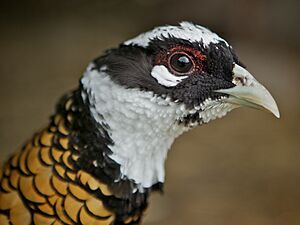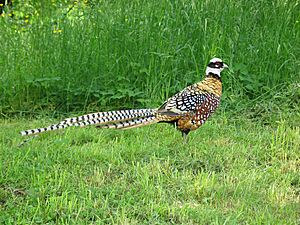Reeves's pheasant facts for kids
Quick facts for kids Reeves's pheasant |
|
|---|---|
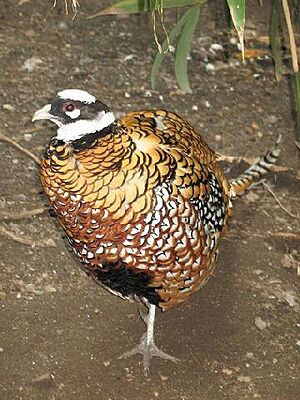 |
|
| Male | |
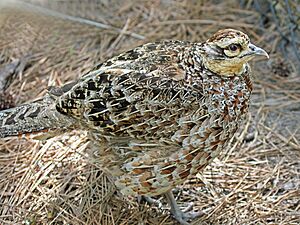 |
|
| Female | |
| Conservation status | |
| Scientific classification | |
| Genus: |
Syrmaticus
|
| Species: |
reevesii
|
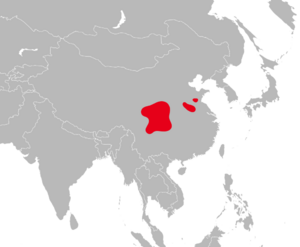 |
|
| Native Range of S. reevesii | |
The Reeves's pheasant (scientific name: Syrmaticus reevesii) is a large and beautiful bird. It belongs to the pheasant family. This bird is special because it naturally lives only in China. It got its name from a British naturalist named John Reeves. He was the first person to bring these amazing birds to Europe in 1831.
Contents
What Does a Reeves's Pheasant Look Like?
Male Reeves's pheasants are very striking. They can grow to be about 210 cm (83 in) (about 7 feet) long. They weigh around 1,529 g (3.371 lb) (about 3.4 pounds). Their bodies are covered in golden-white and red feathers that look like scales. They have grey legs and brown eyes. Around their eyes, the skin is bare and red.
The male's head is white with a thin black band across its eyes. The most amazing part is their tail. It is silvery-white with chestnut brown stripes. This pheasant holds a Guinness World Records record. It has the longest natural tail feather of any bird species! The tail can be as long as 2.4 m (7.9 ft) (almost 8 feet).
Females are smaller than males. They are about 75 cm (30 in) (about 2.5 feet) long. They weigh around 949 g (2.092 lb) (about 2.1 pounds). Their feathers are mostly brown. They have a dark crown on their head and a buff-colored face. Their tail feathers are greyish-brown with stripes.
All Reeves's pheasants look quite similar. There are no different types (subspecies) known.
Where Do Reeves's Pheasants Live?
Reeves's pheasants are native to central and eastern China. They live in temperate forests. These forests can have both evergreen (trees that keep their leaves all year) and deciduous (trees that lose their leaves) trees.
Some of these pheasants have been brought to other countries. These include the United States, Czech Republic, France, and the United Kingdom. People introduced them for sport hunting or just because they are beautiful birds. In some of these places, small groups of them now live and breed in the wild. They can also be found near farmlands if there are woodlands nearby. The male's tail grows about 30 cm (12 in) (about a foot) longer each year.
Reeves's Pheasant Behaviour
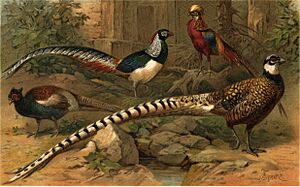
Reeves's pheasants are tough birds. They can handle both very hot and very cold weather. They like to build their nests on higher ground. The female usually lays 7 to 14 eggs in April or May. The eggs hatch after about 24 to 25 days.
These pheasants can sometimes be protective. Especially during the breeding season, they might act aggressively towards people, other animals, or even other pheasants.
Their call is quite unique for a game bird. It sounds more like a musical song than the usual squawk or crow. They mostly eat plants, including seeds and grains. Many people also keep them in aviaries (large bird enclosures) because they are so beautiful.
Protecting Reeves's Pheasants
The Reeves's pheasant is currently listed as a Vulnerable species. This means their numbers are decreasing, and they need protection. There are only about 2,000 of these birds left in the wild.
Their main problems are losing their natural homes (habitat loss) and being hunted too much. People hunt them for food and for their long, beautiful tail feathers.
Because they are vulnerable, the Reeves's pheasant is listed in Appendix II of CITES. CITES is an international agreement. It means that if anyone wants to buy or sell these birds, or even their feathers, across country borders, they need special documents. This helps control trade and protect the species.
See also



